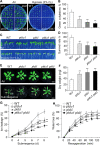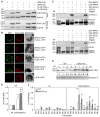Phosphatidic acid modulates MPK3- and MPK6-mediated hypoxia signaling in Arabidopsis
- PMID: 34850198
- PMCID: PMC8824597
- DOI: 10.1093/plcell/koab289
Phosphatidic acid modulates MPK3- and MPK6-mediated hypoxia signaling in Arabidopsis
Abstract
Phosphatidic acid (PA) is an important lipid essential for several aspects of plant development and biotic and abiotic stress responses. We previously suggested that submergence induces PA accumulation in Arabidopsis thaliana; however, the molecular mechanism underlying PA-mediated regulation of submergence-induced hypoxia signaling remains unknown. Here, we showed that in Arabidopsis, loss of the phospholipase D (PLD) proteins PLDα1 and PLDδ leads to hypersensitivity to hypoxia, but increased tolerance to submergence. This enhanced tolerance is likely due to improvement of PA-mediated membrane integrity. PA bound to the mitogen-activated protein kinase 3 (MPK3) and MPK6 in vitro and contributed to hypoxia-induced phosphorylation of MPK3 and MPK6 in vivo. Moreover, mpk3 and mpk6 mutants were more sensitive to hypoxia and submergence stress compared with wild type, and fully suppressed the submergence-tolerant phenotypes of pldα1 and pldδ mutants. MPK3 and MPK6 interacted with and phosphorylated RELATED TO AP2.12, a master transcription factor in the hypoxia signaling pathway, and modulated its activity. In addition, MPK3 and MPK6 formed a regulatory feedback loop with PLDα1 and/or PLDδ to regulate PLD stability and submergence-induced PA production. Thus, our findings demonstrate that PA modulates plant tolerance to submergence via both membrane integrity and MPK3/6-mediated hypoxia signaling in Arabidopsis.
© American Society of Plant Biologists 2021. All rights reserved. For permissions, please email: journals.permissions@oup.com.
Figures








Similar articles
-
Phosphorylation of a WRKY transcription factor by two pathogen-responsive MAPKs drives phytoalexin biosynthesis in Arabidopsis.Plant Cell. 2011 Apr;23(4):1639-53. doi: 10.1105/tpc.111.084996. Epub 2011 Apr 15. Plant Cell. 2011. PMID: 21498677 Free PMC article.
-
The heat shock factor A4A confers salt tolerance and is regulated by oxidative stress and the mitogen-activated protein kinases MPK3 and MPK6.Plant Physiol. 2014 May;165(1):319-34. doi: 10.1104/pp.114.237891. Epub 2014 Mar 27. Plant Physiol. 2014. PMID: 24676858 Free PMC article.
-
Phosphorylation of an ERF transcription factor by Arabidopsis MPK3/MPK6 regulates plant defense gene induction and fungal resistance.Plant Cell. 2013 Mar;25(3):1126-42. doi: 10.1105/tpc.112.109074. Epub 2013 Mar 22. Plant Cell. 2013. PMID: 23524660 Free PMC article.
-
Modes of MAPK substrate recognition and control.Trends Plant Sci. 2015 Jan;20(1):49-55. doi: 10.1016/j.tplants.2014.09.006. Epub 2014 Oct 6. Trends Plant Sci. 2015. PMID: 25301445 Review.
-
New perspectives in flooding research: the use of shade avoidance and Arabidopsis thaliana.Ann Bot. 2005 Sep;96(4):533-40. doi: 10.1093/aob/mci208. Epub 2005 Jul 18. Ann Bot. 2005. PMID: 16027134 Free PMC article. Review.
Cited by
-
Genome-wide identification and expression analysis of phospholipase D gene in leaves of sorghum in response to abiotic stresses.Physiol Mol Biol Plants. 2022 Jun;28(6):1261-1276. doi: 10.1007/s12298-022-01200-9. Epub 2022 Jun 23. Physiol Mol Biol Plants. 2022. PMID: 35910446 Free PMC article.
-
The calcium-dependent protein kinase CPK16 regulates hypoxia-induced ROS production by phosphorylating the NADPH oxidase RBOHD in Arabidopsis.Plant Cell. 2024 Sep 3;36(9):3451-3466. doi: 10.1093/plcell/koae153. Plant Cell. 2024. PMID: 38833610 Free PMC article.
-
Phosphatidic acid-regulated SOS2 controls sodium and potassium homeostasis in Arabidopsis under salt stress.EMBO J. 2023 Apr 17;42(8):e112401. doi: 10.15252/embj.2022112401. Epub 2023 Feb 22. EMBO J. 2023. PMID: 36811145 Free PMC article.
-
ZmPP2C26 Alternative Splicing Variants Negatively Regulate Drought Tolerance in Maize.Front Plant Sci. 2022 Apr 8;13:851531. doi: 10.3389/fpls.2022.851531. eCollection 2022. Front Plant Sci. 2022. PMID: 35463404 Free PMC article.
-
Phospholipid Signaling in Crop Plants: A Field to Explore.Plants (Basel). 2024 May 31;13(11):1532. doi: 10.3390/plants13111532. Plants (Basel). 2024. PMID: 38891340 Free PMC article.
References
-
- Arisz SA, Testerink C, Munnik T (2009) Plant PA signaling via diacylglycerol kinase. Biochim Biophys Acta 1791: 869–875 - PubMed
-
- Bailey-Serres J, Voesenek LA (2008) Flooding stress: acclimations and genetic diversity. Annu Rev Plant Biol 59: 313–339 - PubMed
-
- Bargmann BO, Laxalt AM, ter Riet B, Testerink C, Merquiol E, Mosblech A, Leon-Reyes A, Pieterse CM, Haring MA, Heilmann I, et al. (2009b) Reassessing the role of phospholipase D in the Arabidopsis wounding response. Plant Cell Environ 32: 837–850 - PubMed
Publication types
MeSH terms
Substances
LinkOut - more resources
Full Text Sources
Molecular Biology Databases
Research Materials

